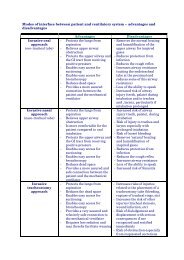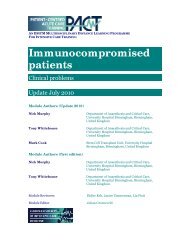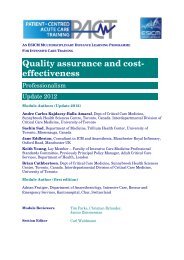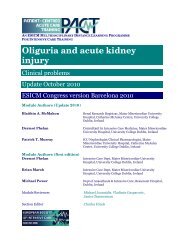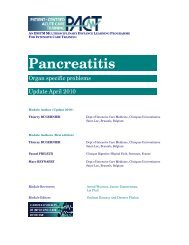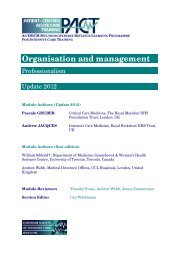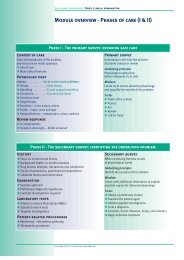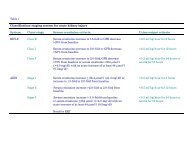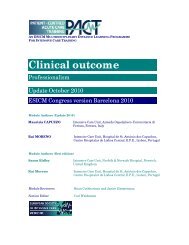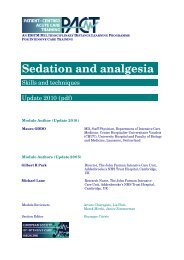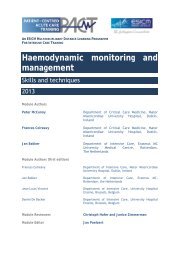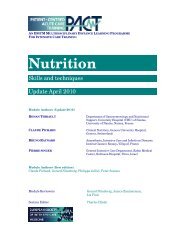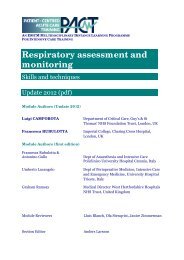Burns injury - PACT - ESICM
Burns injury - PACT - ESICM
Burns injury - PACT - ESICM
You also want an ePaper? Increase the reach of your titles
YUMPU automatically turns print PDFs into web optimized ePapers that Google loves.
Fluid resuscitation (0–24 hrs)<br />
<strong>Burns</strong> exceeding 20% TBSA (10% TBSA in children) are characterised by an early phase<br />
of massive capillary hyperpermeability proportional to the extent of the burn <strong>injury</strong>.<br />
[Images in interactive version]<br />
The transient increase in permeability is caused by the massive liberation of<br />
numerous substances such as histamine, serotonin, cytokines, prostaglandins,<br />
leukotrienes, lipid peroxides, free radicals, myeloperoxidase, and complement.<br />
Studies in animals show that the leakage lasts 24–72 hrs, peaking between 12 and 24<br />
hrs. The only similar clinical condition is anaphylaxis.<br />
The resultant fluid leak causes an interstitial extravasation of intravascular fluid,<br />
potentially resulting in hypovolaemic shock which requires sodium containing isotonic<br />
crystalloids for treatment. During the first 24–48 hrs, molecules up to 100 kdalton in<br />
size escape into the interstitium. Colloids are discouraged in the early phase after<br />
<strong>injury</strong> because they will remain dispersed in the interstitium at the end of the<br />
hyperpermeability phase (their removal being dependent on an effective lymphatic<br />
transport).<br />
According to recommendations, one should fluid resuscitate the burn patient with 2–4<br />
mL/kg/%TBSA (the Parkland formula) using crystalloids. As a small burn size is<br />
frequently overestimated on scene, this formula may cause pre-hospital fluid<br />
overload. Other factors that contribute to the fluid creep (see Complications of fluid<br />
management) are over-sedation and volume guided fluid therapy. Dynamic protocols<br />
for fluid resuscitation managed by nurses may reduce fluid overload in the early<br />
phase.<br />
The primary goal of fluid resuscitation is to maintain adequate tissue perfusion to the<br />
end-organs and the skin in an effort to conserve organ function/skin survival and to<br />
avoid ischaemic <strong>injury</strong>.<br />
Some supplementary critical care signs of<br />
fluid overload<br />
Polyuria > 1.0 mL/kg/hr<br />
cardiac preload (elevated CVP or ITBVI and<br />
PAOP if invasive monitoring instituted)<br />
PaO2/FiO2 ratio<br />
Intra-abdominal pressure >20 mmHg<br />
Abdominal compartment syndrome manifested<br />
by<br />
- Acute kidney <strong>injury</strong><br />
- Visceral ischaemia<br />
CVP: Central venous pressure, ITBVI intrathoracic blood volume index, PAOP<br />
Pulmonary artery occlusion pressure<br />
Remember, CVP (and PAOP) are more useful when used dynamically rather than as<br />
single stand alone measurements – see <strong>PACT</strong> module on Haemodynamic monitoring.<br />
7



